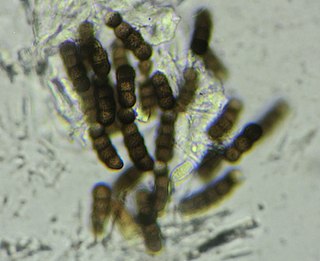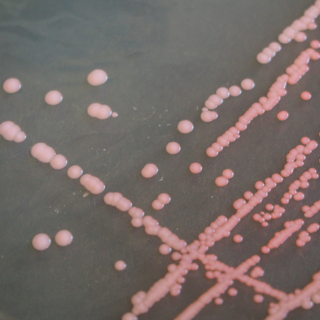Related Research Articles

An agar plate is a Petri dish that contains a growth medium solidified with agar, used to culture microorganisms. Sometimes selective compounds are added to influence growth, such as antibiotics.
Mycobacterium cookii is a species of the phylum Actinobacteria, belonging to the genus Mycobacterium.
Mycobacterium hodleri is a species of the phylum Actinobacteria, belonging to the genus Mycobacterium.
Mycobacterium komossense is a species of the phylum Actinobacteria, belonging to the genus Mycobacterium.

Mannitol salt agar or MSA is a commonly used selective and differential growth medium in microbiology. It encourages the growth of a group of certain bacteria while inhibiting the growth of others. This medium is important in medical laboratories as one method of distinguishing pathogenic microbes in a short period of time. It contains a high concentration of salt (NaCl) which is inhibitory to most bacteria - making MSA selective against most Gram-negative and selective for some Gram-positive bacteria that tolerate high salt concentrations. It is also a differential medium for mannitol-fermenting staphylococci, containing carbohydrate mannitol and the indicator phenol red, a pH indicator for detecting acid produced by mannitol-fermenting staphylococci. Staphylococcus aureus produces yellow colonies with yellow zones, whereas other coagulase-negative staphylococci produce small pink or red colonies with no colour change to the medium. If an organism can ferment mannitol, an acidic byproduct is formed that causes the phenol red in the agar to turn yellow. It is used for the selective isolation of presumptive pathogenic (pp) Staphylococcus species.
Meiothermus timidus is a species of Deinococcus–Thermus yellow-pigmented bacteria. It was first isolated from the hot spring at São Pedro do Sul, in central Portugal, and at the island of Sao Miguel in the Azores. Its type strain is SPS-243T. The species was differentiated with the 16S rRNA gene sequence and biochemical characteristics.
Janibacter is a genus of Gram positive, nonmotile, non-sporeforming bacteria. The genus name is derived from the two-faced Roman god Janus, referring to the fact that the cells of the original strain could be rod-shaped or coccoid.

Mariannaea elegans an anamorphic fungus. It is mainly found on rotting wood and soil. M. elegans is not pathogenic to humans, animals, or plants.

Torula herbarum is a darkly-pigmented filamentous fungus in the phylum Ascomycota. It is often included in the unrelated but morphologically similar group of fungi known as sooty molds. It was first described by Persoon in the genus Monilinia based on similarity to the agent of brown rot of stone fruit but later transferred to the genus Torula by Link. Conidia of T. herbarum are dark brown or olivaceous colour and have a distinctive shape and number of cells. T. herbarum produces secondary metabolites with cytotoxic activity towards bacteria and human cancer cells.
Tumebacillus permanentifrigorisis is a species of Gram positive, strictly aerobic, bacterium. The cells are rod-shaped and form spores. It was first isolated from a 9-meter-deep permafrost sample from the Canadian high Arctic. The species was first described in 2008, and the name refers to its original isolation from permafrost. T. permanentifrigoris was the first species in the new genus, Tumebacillus, and is the type species for the genus. The isolate may have survived 5000–7000 years in ice before being discovered.
Tumebacillus flagellatus is a species of Gram positive, aerobic, bacterium. The cells are rod-shaped, motile, and form spores. It was first isolated from wastewater from a cassava processing plant in Guangxi, China. The species was first described in 2013, and the name refers to the flagella found in the cells. T. flagellatus was the third species of Tumebacillus to be discovered, but was the first found to be motile. T. flagellatus was found during a survey for bacteria that were able to hydrolyze pullulan or starch.
Tumebacillus ginsengisoli is a species of Gram positive, aerobic, bacterium. The cells are rod-shaped, non-motile, and form spores. It was first isolated from soil in a ginseng field in Pocheon, South Korea, and the species name is derived from the ginseng soil isolation location. T. ginsengisoli was the second species added to the genus Tumebacillus.
Tumebacillus luteolus is a species of Gram positive, aerobic, bacterium. The cells are rod-shaped, non-motile, and form spores. It was first isolated from soil in Ukraine. The species was first described in 2015, and the name is derived from Latin luteolus (yellowish), referring to the colony color on R2A agar.
Fodinibacter luteus is a species of Gram positive, nonmotile, non-sporeforming bacteria. The bacteria are strictly aerobic and mesophilic, and the cells are irregular rods. It was originally isolated from a salt mine in Yunnan, China. The species name is derived from luteus (yellow), referring the bacterial colony color on agar. F. luteus is the type species of genus Fodinibacter, and is currently the only species in the genus.

Arthrobacter bussei is a pink-coloured, aerobic, coccus-shaped, Gram-stain-positive, oxidase-positive and catalase-positive bacterium isolated from cheese made of cow´s milk. A. bussei is non-motile and does not form spores. Rod–coccus life cycle is not observed. Cells are 1.1–1.5 µm in diameter. On trypticase soy agar it forms pink-coloured, raised and round colonies, which are 1.0 mm in diameter after 5 days at 30 °C The genome of the strain A. bussei KR32T has been fully sequenced.

In microbiology, colonial morphology refers to the visual appearance of bacterial or fungal colonies on an agar plate. Examining colonial morphology is the first step in the identification of an unknown microbe. The systematic assessment of the colonies' appearance, focusing on aspects like size, shape, colour, opacity, and consistency, provides clues to the identity of the organism, allowing microbiologists to select appropriate tests to provide a definitive identification.
Knoellia flava is a species of Gram positive, nonmotile, non-sporeforming bacteria. The bacteria are aerobic and mesophilic, and the cells can be irregular rods or coccoid. It was originally isolated from pig manure from Huazhong Agricultural University in Wuhan, China. The species name is derived from Latin flava (yellow), referring to the colony color of the species when grown on R2A agar.
Lapillicoccus jejuensis is a species of Gram positive, nonmotile, non-sporeforming bacteria. The bacteria are aerobic and mesophilic, and the cells are coccoid. The species was first described in 2007, and it was originally isolated a stone in Jeju, South Korea. The species name refers to the area (Jeju) from which it was first isolated. L. jejuensis is the type species of genus Lapillicoccus, and is currently the only species in the genus.
Marihabitans asiaticum is a species of Gram positive, nonmotile, non-sporeforming bacteria. The bacteria are aerobic and mesophilic, and the cells are irregular rods or coccoid. The species was first described in 2008, and it was originally isolated in 2003 from surface seawater collected at the Kesennuma ferry port in Miyagi Prefecture, Japan. The species name refers to the region (Asia) from which it was first isolated. M. asiaticum is the type species of genus Marihabitans, and is currently the only species in the genus.
Ornithinibacter is a genus of Gram positive, nonmotile, non-sporeforming bacteria. The bacteria are strictly aerobic and mesophilic. Cells of the genus are irregular rods that form branching hyphae. The genus name refers to L-Ornithine, the major diagnostic diamino acid in the peptidoglycan. The genus is monospecific, with O. aureus as the only species.
References
- 1 2 Xiao, Chuan; Huang, Huiqin; Ye, Jianjun; Wu, Xiaopeng; Zhu, Jun; Zhan, Baolin; Bao, Shixiang (1 March 2011). "Ornithinibacter aureus gen. nov., sp. nov., a novel member of the family Intrasporangiaceae". International Journal of Systematic and Evolutionary Microbiology. 61 (3): 659–664. doi:10.1099/ijs.0.022806-0. PMID 20400663.
- ↑ "Genus Ornithinibacter". LPSN - List of Prokaryotic names with Standing in Nomenclature. Retrieved 7 May 2020.